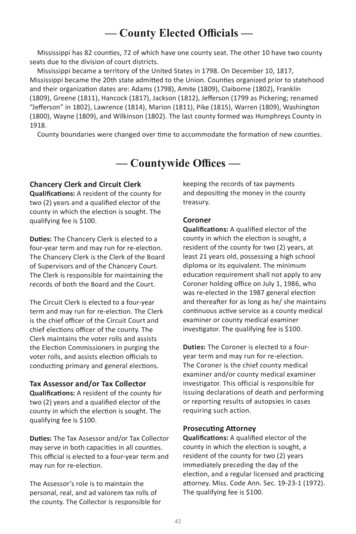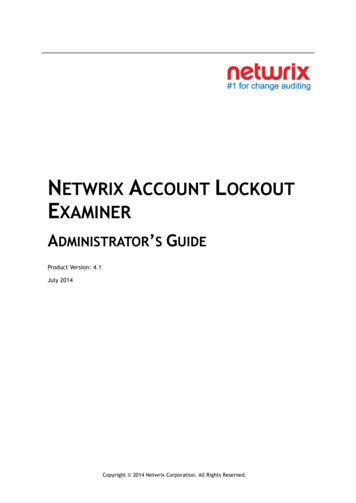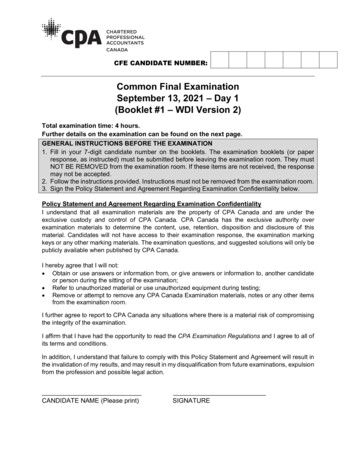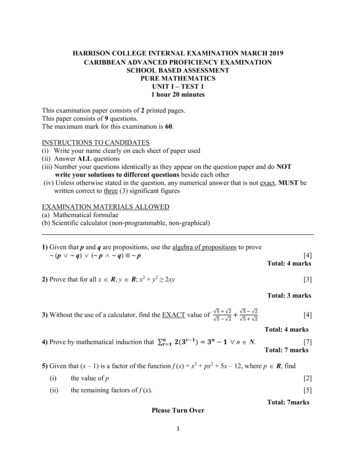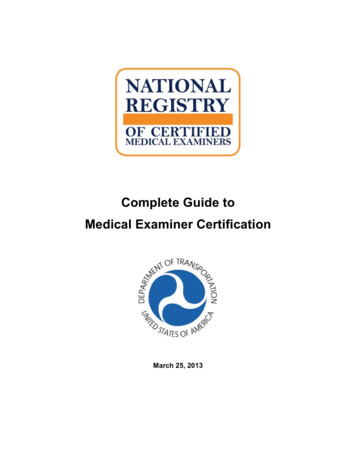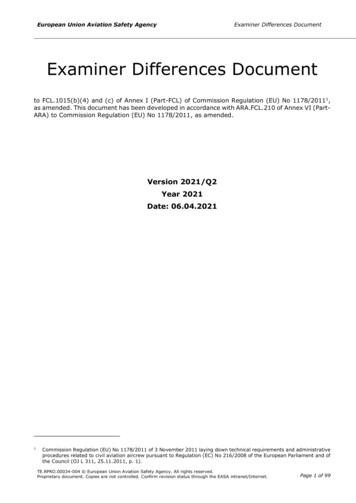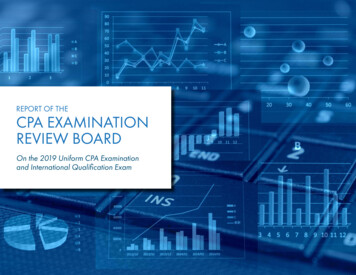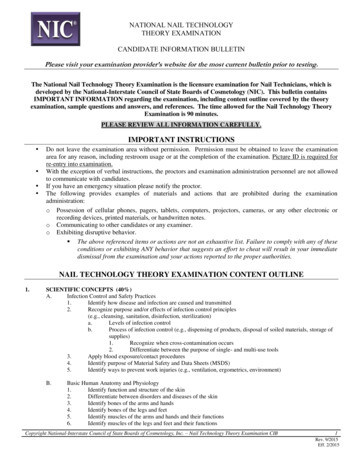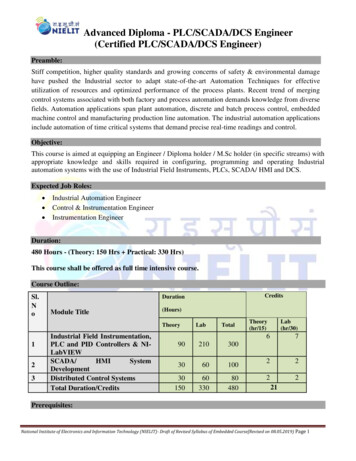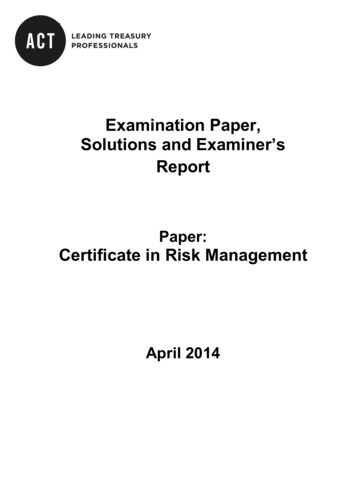
Transcription
04Examination Paper,Solutions and Examiner’sReportPaper:Certificate in Risk ManagementApril 2014
SECTION A – Answer TWO COMPULSORY questionsQUESTION 1RRR, a company based in New Zealand, manufactures a specialised homesecurity product. Most of the shares are held by large global institutions. Themajority of sales (by value) are to customers in New Zealand (priced in NewZealand Dollars, NZD) but there are also significant export sales to customers inthe USA, priced in USD. All costs are in NZD. RRR has two main competitors,both based in the USA.Financial data for RRR for the year ended 31 December 2013NZD millionNotesStatement of Profit or LossRevenue150EBITDA25This includes NZD 60 million relating toUSD sales, converted at an average rateof USD/NZD 1.2800Statement of Financial Position at start of yearCash and cash equivalents105% bonds(40)Bank borrowings(20)No interest earnedInterest charge of 5% on opening balanceBank borrowings are subject to debt covenants where net debt/EBITDA shouldnot exceed 3.5 times and interest cover should be at least 4 times (based onEBITDA).VaR analysis of USD/NZD spot movementsRRR’s Treasury Analyst has been asked to investigate the worst and best casescenarios for USD/NZD spot over the next year assuming a lognormaldistribution for market rates, annual volatility of 12% and today’s spot rate ofUSD/NZD 1.2800. The results are shown below:1CRM
Expected USD/NZD spot rate at Z values of 3 and -32USD/NZD spot1.81.61.4 3Z1.2- 3Z10.8050100150200250Days to maturity300350400Required:(a)(i)Define the term ‘risk appetite’.(1 mark)(ii)Identify THREE key factors that are likely to influence acompany’s risk appetite and discuss each in the context of RRR.(5 marks)(iii) Explain the nature of RRR’s foreign exchange exposure andassess the extent of such exposure. Your answer should includea sensitivity table for net debt/EBITDA and EBITDA/interestbased on USD/NZD rates of 1.2800, 1.2000, 1.1000, 1.0000 and0.9000.(10 marks)(b)(i)Calculate the best and worst exchange rate outcomes in 100days’ time using lognormal VaR and Z values of 3 and -3. Noadjustment is required for forward points.(4 marks)(ii)State the probability of USD/NZD spot being between the ratescalculated in (b)(i) above in 100 days’ time.(1 mark)Hedging policyRRR does not have a formal hedging policy, although, in the past, occasionalhedging deals have been entered into if it was considered that the spot rate wasat a favourable level historically. RRR’s Board has delegated responsibility forhedging policy to its Risk Management Committee (RMC). Two Directors sittingon the RMC have expressed reservations about carrying out any hedging forforeign exchange risk.2CRM
Director A considers that the USD/NZD spot rate is equally likely to move up ordown and that, over the longer term, such movements are likely to cancel outand therefore there is unlikely to be any long term financial benefit from hedgingforeign exchange exposures.Director B is of the opinion that shareholders should have been aware of theforeign currency profile of the company when they invested in it and wouldexpect to benefit from favourable exchange rate movements. Therefore thecompany should not carry out any foreign exchange hedging so that it can stillbenefit from favourable rate movements.Required:(c)Respond to the views expressed by Directors A and B, concludingwith a recommendation of an appropriate risk response for RRR.(9 marks)(Total 30 marks)3CRM
QUESTION 2Assume today is 30 June 2014.A Japanese company, QQQ, has significant exports to customers in Hong Kong,priced in HKD. The foreign exchange exposure arising from export sales is nothedged at present but the Board of QQQ has taken the decision to introduce anew hedging strategy with effect from 30 June 2014.Under this new hedging strategy, forecast future HKD sales receipts are to behedged using forward contracts up to 12 months out on a rolling month-on-monthbasis. Only 80% of forecast receipts are to be hedged in order to help meethedge accounting effectiveness tests.The first transaction under the new hedging strategy is to be carried out today,30 June 2014, entering into a 12 month forward contract to hedge 80% offorecast HKD 10 million sales receipts due on 30 June 2015. IAS 39 hedgeaccounting regulations will be applied, treating hedged positions as cash flowhedges.Required:(a)Explain why this hedge will be accounted for as a cash flow hedgerather than a fair value hedge.(2 marks)On 30 June 2014, market rates are:HKD/JPY 12 months forward:12.7600On 30 September 2014, market rates are:HKD/JPY 9 months forward:12.5400JPY 9 month interest rate: 2.0% (act/365)Required:(b)(i)Calculate the fair value, as at 30 September 2014, of the 12 monthforward contract taken out on 30 June 2014. Ignore credit spreadand transaction costs.(4 marks)(ii)Explain how this 12 month forward contract would be accountedfor when: Initially entered into on 30 June 2014 Re-valued on 30 September 2014 The hedged sales are invoiced and hence the sale recognisedin profit or lossNo calculations are required in part (b) (ii)(4 marks)(Total 10 marks)4CRM
SECTION B – Answer THREE questions from FOURQUESTION 3Assume money market rates are as follows:MaturityOvernight3 day7 day30 days90 daysUSD (act/360)2.4%2.5%2.8%3.3%3.9%AUD (act/365)4.4%4.5%4.7%5.7%6.5%Assume USD/AUD spot is 1.0923.Company A is based in the USA. The Treasurer of Company A is consideringhow best to invest USD 50 million cash that is forecast to be surplus for 90 days.Three alternative short term investments are being considered, each with thesame counterparty, as follows:Investment 1Investment 2Investment 33 day USD money market deposit to be rolled overevery 3 days over the 90 day period and interestreinvested90 day USD money market deposit90 day AUD money market depositRequired:(a)(b)(i)Calculate the 90 day USD/AUD forward rate implied by the moneymarket rates provided.(2 marks)(ii)Discuss the extent to which the forward rate is a good indicatorof the spot rate in 90 days’ time.(2 marks)(i)Describe the key principles of short term investment.(4 marks)(ii)Calculate the effective annual return for each of the investments1 to 3 listed above assuming that interest rates and exchangerates remain unchanged over the 90 day term.(3 marks)(iii) Compare and contrast the risks and benefits to Company A ofinvestments 1 to 3 with reference to the key principles of shortterm investment.(9 marks)(Total 20 marks)5CRM
QUESTION 4PENSK is a defined benefit pension scheme located in the UK. Company PK isthe sponsor company for PENSK.PENSK’s investments have a total value of GBP 900 million, of which 60% isinvested in equities and 40% in bonds. Pension payment liabilities are estimatedto be approximately GBP 88 million a year for the next 15 years.The bonds have an AA credit rating and range in maturity from 2 to 20 years,with a modified duration of 9.3 years and modified convexity of 123.0. The yieldto maturity on the bonds is currently 4%.PENSK’s Trustees are currently reviewing the risk profile of both the schemeassets and liabilities.The Trustees are aware that Quantitative Easing (QE) programmes cannegatively affect pension schemes.Advisers to PENSK expect a QEprogramme to be announced shortly and that this would lead to a fall in interestrates, coupled with an increase in the value of equities. Equity values areexpected to rise by approximately 2% for each 1% fall in interest rates. Bondyields can be assumed to move in line with interest rates.Required:(a)Explain the following risk factors and their potential impact on adefined pension scheme value (no calculations are required): Changing interest ratesA credit rating downgrade of a corporate bond held as aninvestment(4 marks)(b)(i)Calculate the PENSK scheme surplus or def
30 June 2014, entering into a 12 month forward contract to hedge 80% of forecast HKD 10 million sales receipts due on 30 June 2015. IAS 39 hedge accounting regulations will be applied, treating hedged positions as cash flow hedges. Required: (a) Explain why this hedge will be accounted for as a cash flow hedge rather than a fair value hedge.
